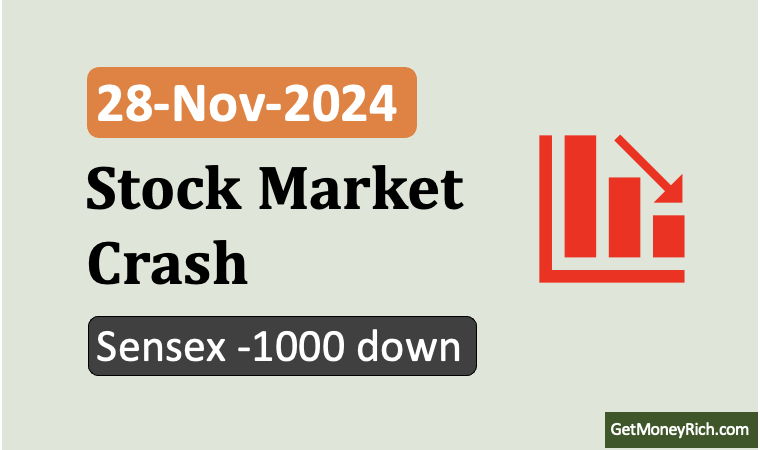The Indian stock market has experienced significant volatility and downturns due to a confluence of several global and domestic factors. In this blog post, I’ll try to cover various reasons that are kind of collectively contributing the recent fall in the Indian market. Suggested Reading: Signals of a stock market crash.
Reason #1 Global Economic Concerns
#1.1 US Economic Indicators:
Weak job data, fears of a recession, and concerns over inflation in the US have led to a cautious approach by investors globally.
The possibility of the US Fed further reducing interest rates also adds to the uncertainty. As a result, foreign institutional investors (FIIs) are reallocating their investments from emerging markets like India to more stable markets.
When the US Federal Reserve considers lowering interest rates, it often leads to a decrease in the yield on US securities. This prompt FIIs to seek higher returns in more stable or emerging markets.
However, this adjustment also increases uncertainty about global economic stability. FIIs tend to initially retreat to what they perceive as safer investments.
As Feds have reduced the interest rate, FIIs are seeking to deploy their funds from US to emerging markets.
#1.1.1 China Effect
In the same period, China has recently implemented several measures to attract FIIs. China has launched a significant funding schemes to boost its stock market. For example, a $112 billion initiative by China is aimed at enhancing market liquidity. Additionally, China has extended tax policies beneficial for foreign investment. The have also issued special bonds to manage local government debt. The have also introduced new programs like the Qualified Foreign Institutional Investor (QFII) to allow more foreign investment in its capital markets.
On one hand, China is taking these steps to attract FIIs and on the other hand, FIIs have shown their concerns about Indian market being overvalued.
Hence, FIIs are selling their holdings in India and deploying the sale proceeds in China.
#1.2 Geopolitical Tensions
Conflicts in the Middle East, particularly involving Iran and Israel, contribute to global market instability.
Such tensions often lead to fluctuations in oil prices, which directly impact economies like India that are heavily dependent on oil imports.
Though, the current market (as in Oct 2024) fall is not drawing too much weight from this reason, but it is surely affecting the macros negatively.
Reason #2: FII Influence vs DIIs Influence
| Category | Date | Buy Value (₹ Crores) | Sell Value (₹ Crores) | Net Value (₹ Crores) |
| DII ** | 22-Oct-24 | 16,865.80 | 10,996.74 | 5,869.06 |
| FII/FPI * | 22-Oct-24 | 15,579.80 | 19,558.41 | -3,978.61 |
Check this FII & DII Data I have downloaded from NSEINDIA’s website for 22-Oct-2024.
Yesterday, the Indian stocks market saw a big sell-off. But from the data of NSEINDIA’s website, DII’s were the net buyers by Rs.5869 crore. Whereas, FII’s were net sellers with Rs.-3978 crore worth of selling. As per this data, DII have bought more than what FIIs have sold, right?As per this data, DII have bought more than what FIIs have sold, right?
So some might ask, why the market still tanked? The reason could be this:
- FII Influence: FIIs generally have a larger impact on market sentiment. Their selling can create panic, especially in volatile markets. When FIIs are selling heavily, it often leads to a broader sell-off by retail investors and smaller institutions. Moreover, when FIIs are selling, investors in F&O segment panics and they also start to exit. F&O trading can have a very large impact on the stocks and broader indices.
- Blue Chip Selling: FIIs tend to have large holdings in blue-chip stocks and specific sectors (e.g., IT, banking). If their selling was concentrated in those sectors, it could drag down major indices, even if DIIs bought other stocks.
Reason #3. Domestic Factors
- Overbought Conditions: Prior to recent falls, the Indian market had seen a significant rally, leading to overbought conditions. This often results in a market correction, as short-term investors seek to book profits. Even long-term investors may try to sell expensive stocks in the portfolio to lower the downside risks.
- Currency Fluctuations: The rebound in the US dollar has made dollar-denominated investments more attractive. It is also leading to capital outflows from India. This type of capital flow puts pressure on rupee (currency value) and Indian equities.
- Interest Rate Environment: Even in India, RBI is expected to lower the interest rates. But that rate cut has not happened. Such kind of situation also leads to uncertainty and potential sell-off in the market,
Reason #4. Market Sentiment (VIX)
The India VIX, known as the fear index, had seen significant spikes.
In the last one week, the VIX has increased by almost 10%. It is an indication of increased investor anxiety and contributing to market sell-offs.
As on date (22-Oct-2024), the VIX is at 14.34. As a general rule of thumb, VIX getting over 10 means high volatility.
Have a happy investing.






